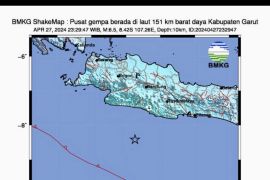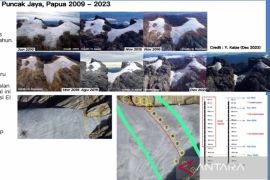"The decreased frequency shows that the condition would be safe again," head of the BMKG’s Earthquake and Tsunami Center Daryono said during a meeting with Commission V of the House of Representatives (DPR RI) in Jakarta on Tuesday.
As of 4 p.m. local time on Tuesday, 140 aftershocks were recorded with a decreasing frequency of occurrence, he informed.
The magnitude of the aftershocks also weakened compared to the main earthquake in Cianjur on Monday, which measured 5.6 in magnitude, he added.
"The biggest aftershock had a magnitude of 4.2 and the smallest had a magnitude of 1.2," he disclosed.
According to Daryono, an earthquake with a magnitude of 1.2 could finally be analyzed by the BMKG, and this was an achievement in earthquake monitoring.
"We were able to analyze an earthquake of 1.2 magnitude. This was our brilliant achievement in monitoring earthquakes because of the many tools we have installed; we can provide detailed information regarding the earthquake activity that occurred," he informed.
Based on an analysis of the source mechanism, the earthquake in Cianjur had a sliding fault to the left, he said.
"This is similar to the characteristics of the Cimandiri fault. We suspect that the main earthquake is part of the Cimandiri fault because it is indeed in the fault system zone," he added.
Daryono said that the movement of the fault tore the ground around 20–30 kilometers below the ground surface and the fracture reached 23 km.
“So, indeed, this will emit very strong but shallow earthquake waves," he explained.
As a result, buildings that were at the epicenter of the earthquake suffered damage. Meanwhile, the soft ground conditions also worsened the shaking.
"Because the soft ground resonated with the vibrations. Thereby, it amplified the shaking. We can see that there were many damaged buildings and fatalities," he said.
The impact of the earthquake also caused the slopes to become unstable, which could result in landslides, especially when it rains, he added.
"The hills were shaken by the earthquake; the slopes could experience instability. We must anticipate a landslide," he said.
Related news: Cianjur quake: Death toll climbs to 268
Related news: 142 school buildings damaged in Cianjur quake: official
Related news: Need to monitor nutritional intake of Cianjur child victims: BKKBN
Translator: Zubi Mahrofi, Resinta S
Editor: Azis Kurmala
Copyright © ANTARA 2022












